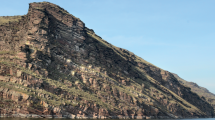Abstract
Biogenic weathering is caused by the action of lithobiontic organisms. Homogeneous carbonates are predominantly colonized by endolithic species that actively penetrate the rock substratum independent of already existing pores or fissures. The organisms construct a system of ducts and cavities by active dissolution of the substratum. A fresh, noncolonized surface is penetrated by algae and ascomycetes in the first and second year after exposure to the environment. The establishment of complex colonization patterns on and in the substratum by lichens takes several years. In spite of the primary deteriorative effect on their substratum by the organisms, long-term endolithic growth also involves mechanisms that stabilize and preserve the rock surface morphology. A tightly woven cellular network may strengthen the colonized stone. This feature is of importance when natural and building stone are affected by biogenic weathering phenomena.





Similar content being viewed by others
References
Banfield JF, Barker WW, Welch SA, Taunton A (1999) Biological impact on mineral dissolution: application of the lichen model to understanding mineral weathering in the atmosphere. Proc Natl Acad Sci USA 96:3404–3411
Ettl H, Gärtner G (1995) Syllabus der Boden-, Luft- und Flechtenalgen. Gustav Fischer, Stuttgart
Friedman EI (1980) Endolithic microbial life in hot and cold deserts. Origins Life Evol Biosphere 10:223–235
Friedman EI, Ocampo R (1976) Endolithic blue-green algae in the dry valleys; primary producers in the Antarctic desert ecosystem. Science 193:1247–1249
Golubic S, Friedmann EI, Schneider J (1980) The lithobiontic ecological niche, with special reference to microorganisms. J Sediment Petrol 51:475–478
Gorbushina AA, Krumbein, WE, Hamman CH, Panina L Soukharjevski S, Wollenzien U (1993) Role of black fungi in color-change and biodeterioration of antique marbles. Geomicrobiol J 11:205–221
Hoppert M, Holzenburg A (1998) Electron microscopy in microbiology. RMS Handbook Series No. 43, Bios Scientific, Oxford
Hoppert M, Berker R, Flies C, Kämper M, Pohl W, Schneider J, Ströbel S (2002) Biofilms and their extracellular environment on geomaterials: methods for investigation down to nanometre scale. Geological Society of London, Spec Publ 205, pp 207–215
Klement O (1953) Prodromus der mitteleurpäischen Flechtengesellschaften. Feddes Repert Beih 135:5–194
Kurtz HD, Netoff DI (2001) Stabilization of friable sandstone surfaces in a desiccating, wind-abraded environment of south-central Utah by rock surface microorganisms. J Arid Environ 48:89–100
Pohl W (2000) Wechselwirkungen zwischen endolithischen Biofilmen und Karbonatgesteinen in alpinen Gebieten Mitteleuropas. PhD Thesis, Universität Göttingen
Stanley JT (1968) Prosthecomicrobium and Ancalomicrobium: new prosthecate freshwater bacteria. J Bacteriol 95:1921–1942
Starr RC (1971) Algal cultures: sources and methods of cultivation. Meth Enzymol 23:29–53
Sterflinger K, Krumbein WE (1997) Dematiaceous fungi as a major agent for biopitting on Mediterranean marbles and limestones. Geomicrobiol J 14:219–230
Weed R, Norton SA (1991) Siliceous crusts, quartz rinds and biotic weathering of sandstones in the Cold desert of Antarctica. In: Berthelin J (ed) Diversity of environmental biogeochemistry. Elsevier, Amsterdam, pp 327–339
Wessels DCJ (1988) Mechanism and rate of weathering of Clarens sandstone by an endolithic lichen. S Afr J Sci 84:274–277
Wessels DCJ, Büdel B (1995) Epilithic and cryptoendolithic cyanobacteria of Clarens sandstone cliffs in the Golden Gate Highlands National Park, South Africa. Bot Acta 108:220–226
Wilson MJ (1995) Interactions between lichens and rocks: a review. Cryptogamic Bot 5:299–305
Acknowledgement
This work has been supported by grants from the Deutsche Forschungsgemeinschaft (SFB 471).
Author information
Authors and Affiliations
Corresponding author
Additional information
Special issue: Stone decay hazards
Rights and permissions
About this article
Cite this article
Hoppert, M., Flies, C., Pohl, W. et al. Colonization strategies of lithobiontic microorganisms on carbonate rocks. Env Geol 46, 421–428 (2004). https://doi.org/10.1007/s00254-004-1043-y
Received:
Accepted:
Published:
Issue Date:
DOI: https://doi.org/10.1007/s00254-004-1043-y




